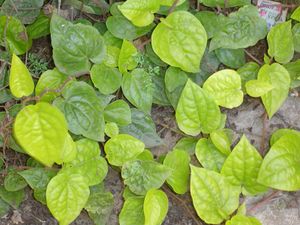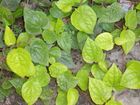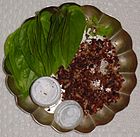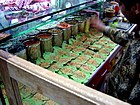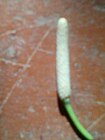Note: This is a project under development. The articles on this wiki are just being initiated and broadly incomplete. You can Help creating new pages.
Difference between revisions of "Piper betle - Nagavallari"
(→How to plant/cultivate) |
(→Mode of Propagation) |
||
| Line 52: | Line 52: | ||
==Where to get the saplings== | ==Where to get the saplings== | ||
==Mode of Propagation== | ==Mode of Propagation== | ||
| − | + | {{Propagation|Cuttings}}. | |
==How to plant/cultivate== | ==How to plant/cultivate== | ||
Revision as of 17:11, 11 June 2019
Piper betle are eulogized by ayurveda acharyas for their immense medicinal properties. Piper betle is a vine which belongs to Piperacea family. This vine has heart shaped leaves and is mostly grown in South East Asia.
Contents
- 1 Uses
- 2 Parts Used
- 3 Chemical Composition
- 4 Common names
- 5 Properties
- 6 Habit
- 7 Identification
- 8 List of Ayurvedic medicine in which the herb is used
- 9 Where to get the saplings
- 10 Mode of Propagation
- 11 How to plant/cultivate
- 12 Commonly seen growing in areas
- 13 Photo Gallery
- 14 References
- 15 External Links
Uses
Wounds, Joint pains, Stomach colicky, Indigestion, Bad breath, Weight loss, Erectile disfunction, Diarrhea, Sore throats.
Parts Used
Chemical Composition
Leaf contains Water (85-90%), Proteins (3-3.5%), Carbohydrates (0.5-6.1%), Minerals (2.3-3.3%), Fat (0.4-1%), Fibre (2.3%), Essential oil (0.08-0.2%), Tannin (0.1-1.3%), Alkaloid (arakene)[1]
Common names
| Language | Common name |
|---|---|
| Kannada | Veelyade Ele |
| Hindi | |
| Malayalam | |
| Tamil | Vettilai |
| Telugu | Tamalapaku |
| Marathi | NA |
| Gujarathi | NA |
| Punjabi | NA |
| Kashmiri | NA |
| Sanskrit | |
| English | Betel pepper |
Properties
Reference: Dravya - Substance, Rasa - Taste, Guna - Qualities, Veerya - Potency, Vipaka - Post-digesion effect, Karma - Pharmacological activity, Prabhava - Therepeutics.
Dravya
Rasa
Tikta (Bitter), Kashaya (Astringent)
Guna
Laghu (Light), Ruksha (Dry), Tikshna (Sharp)
Veerya
Ushna (Hot)
Vipaka
Katu (Pungent)
Karma
Kapha, Vata
Prabhava
Habit
Identification
Leaf
| Kind | Shape | Feature |
|---|---|---|
| Simple | ovate-oblong | Those at apex of stem sometimes elliptic, 7-15 × 5-11 cm |
Flower
| Type | Size | Color and composition | Stamen | More information |
|---|---|---|---|---|
| Unisexual | 2-4cm long | Yellow | 2 | Flowers Season is May-Jul |
Fruit
| Type | Size | Mass | Appearance | Seeds | More information |
|---|---|---|---|---|---|
| General | 7–10 mm | clearly grooved lengthwise, Lowest hooked hairs aligned towards crown | many | {{{6}}} |
Other features
List of Ayurvedic medicine in which the herb is used
Where to get the saplings
Mode of Propagation
How to plant/cultivate
Cuttings 30 - 45cm long, taken from the tips of vertical shoots[310 ]. Cuttings usually have 3 - 5 nodes and are planted with the lowest 2 nodes buried in the soil. The cuttings are planted in nurseries or, more commonly, directly in the field, where they are planted close together in pits or long mounds. When the cuttings begin to sprout and creep along, they are tied to the support[4]
Commonly seen growing in areas
Trophical area, Coastal areas.
Photo Gallery
References
External Links
- Ayurvedic Herbs known to be helpful to treat Wounds
- Ayurvedic Herbs known to be helpful to treat Joint pains
- Ayurvedic Herbs known to be helpful to treat Stomach colicky
- Ayurvedic Herbs known to be helpful to treat Indigestion
- Ayurvedic Herbs known to be helpful to treat Bad breath
- Ayurvedic Herbs known to be helpful to treat Weight loss
- Ayurvedic Herbs known to be helpful to treat Erectile disfunction
- Ayurvedic Herbs known to be helpful to treat Diarrhea
- Ayurvedic Herbs known to be helpful to treat Sore throats
- Herbs with Vines used in medicine
- Herbs with Leaves used in medicine
- Herbs with Roots used in medicine
- Herbs with Fruits used in medicine
- Herbs with common name in Kannada
- Herbs with common name in Tamil
- Herbs with common name in Telugu
- Herbs with common name in English
- Habit - Evergreen climbing shrub
- Index of Plants which can be propagated by Cuttings
- Herbs that are commonly seen in the region of Trophical area
- Herbs that are commonly seen in the region of Coastal areas
- Herbs
- Piperaceae
